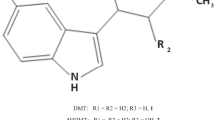Abstract
A novel bivalent opioid tetrapeptide, biphalin (Tyr-d-Ala-Gly-Phe-NH)2, was synthesized based on structure-activity relationships. The analgesic activity of biphalin was assessed in comparison to morphine in rats. Drugs were administered subcutaneously (s.c.), intravenously (i.v.) and intrathecally (i.t.). Tail flick and tail pinch were used as tests for analgesia. Biphalin s.c. showed negligible analgesic activity, but when given i.v. produced significant analgesia, although less potent than morphine via this route. In contrast, intrathecal biphalin was more potent than morphine. These results indicate that biphalin has intrinsic activity that is compromised by enzymatic degradation or redistribution in the periphery, properties that may render it useful in exploring analgesic actions of locally applied opioids in the periphery without the likelihood of unwanted central effects.
Similar content being viewed by others
References
D. B. Carr,Opioids. Int. Anaesthesiol. Clinics26, 273–287 (1988).
A. W. Lipkowski,Cooperative reinforcement of opioid pharmacophores. Pol. J. Pharmacol. Pharm.39, 585–596 (1987).
J. F. Calimlim, F. M. Wardell, K. Sriwatanukul, L. Lasagna and C. Cox,Analgesic efficacy of parenteral metkephamide acetate in treatment of postoperative pain. Lancet1, 1374–1375 (1982).
R. C. A. Fredrickson, R. E. Chipkin,Endogenous opioids and pain: status of human studies and new treatment concepts. Prog. Brain Res.77, 407–417 (1988).
A. W. Lipkowski, A. M. Konecka and I. Sroczynska,Double-enkephalins — synthesis, activity on guinea-pig ileum, and analgesic effect, Peptides3, 697–700 (1988).
A. W. Lipkowski, A. M. Konecka, I. Sroczynska, R. Przewlocki, L. Stala and S. W. Tam,Bivalent opioid peptide analogues with reduced distances between pharmacophores. Life Sci.40, 2283–2288 (1987).
S. A. Krumins and D. Rodbard,Comparative studies of the binding of dimeric and monomeric enkephalins to the neuroblastoma-glioma NG 108-15 cells. J. Neurochem.45, 101–107 (1985).
J. Kamei and Y. Kasuya,Effects of double-enkephalin (biphalin), an enkephalin analogue, on respiration and the cough reflex in rats. J. Pharmacobio-dyn.11, 645–650 (1988).
H. O. Handwerker,Pain and inflammation. Pain, supplement5, S217 (1990).
T. L. Yaksh and T. A. Rudy,Chronic catheterization of the spinal subarachnoid space. Physiol. Behav.17, 1031–1036 (1976).
B. C. Yoburn, R. Morales, D. D. Kelley and C. E. Inturrisi,Constraints of the tail flick assay: morphine analgesia and tolerance are dependant upon locus of tail stimulation. Life Sci.34, 1755–1762 (1984).
R. D. E. Sewell, P. S. J. Spencer and N. Upton,Antinociceptive activity of some mu and kappa agonists determined by combined nociceptive testing method. Br. J. Pharmacol.74, 284P (1981).
J. W. Kemp, P. F. Osgood, A. Kazianis, N. E. Atchison, D. B. Carr and S. K. Szyfelbein,Tail pinch latency test: conditioned vocalization improves reliability without producing opioid mediated stress analgesia. American Physiological Society/American Society for Pharmacology and Experimental Therapeutics (abstracts)108.18 (1988).
R. J. Tallarida and R. B. Murray,Manual of Pharmacological calculations with computer programs.2d ed. Springer-Verlag, New York 1978.
SAS Users Guide Version 5 Edition. SAS Institute, Box 8000, Cary, N.C. 27511.
D. B. Carr and J. C. Ballantyne,Endorphins and analgesia. Compr. Ther.13, 7–13 (1987).
C. J. Evans, D. L. Hammond and R. C. A. Fredrickson,The opioid peptides. In:The opiate receptors (Ed. G. W. Paternak) pp. 23–71. The Human Press, Clifton, New Jersey, 1988.
D. B. Carr, A. W. Lipkowski and B. S. Silbert,Opioid peptides. In:Opioids in anaesthesia II (Ed. F. G. Estafanous) pp. 3–16. Butterworth, Boston 1991 pp. 3–16.
D. B. Carr,Pain. In:Clinical anaesthesia procedures of the Massachusetts General Hospital, 3d ed. (Eds. L. L. Firestone, P. W. Lebowitz and C. E. Cook) pp. 571–585. Little, Brown and Company, Boston/Toronto 1988.
Neurological Applications of Implanted Drug Pumps. In: The New York Academy of Sciences abstracts (Ed. R. D. Penn)531, New York, N.Y. 1987.
H. Akil, S. J. Watson, E. Young, M. E. Lewis, H. Khachaturian and M. Walker,Endogenous opioids: biology and function. Ann. Rev. Neurosci.7, 223–255 (1984).
J. L. Joris, T. Dubner and K. M. Hargreaves,Opioid analgesia at peripheral sites. Anesth. Analg.66, 1277–1281 (1987).
C. G. Parsons, A. Czlonkowski, C. Stein and A. Herz,Peripheral opioid receptors mediating antinociception in inflammation. Activation by endogenous opioids and role of the pituitary-adrenal axis. Pain4, 81–93 (1990).
P. Stewart and L. Isaac,Localization of dynorphin-induced neurotoxicity in rat spinal cord. Life Sci.44, 1505–1514 (1989).
J. B. Long, W. C. Mobley and J. W. Holoday,Neurological dysfunction after intrathecal injection of dynorphin A (1–13) in the rat. I. Injection procedures modify pharmacological responses. J. Pharmacol. Exp. Ther.246, 1158–1166 (1988).
J. Long,Spinal subarachnoid injection of somatostatin causes neurological deficits and neuronal injury in rats. Eur. J. Pharmacol.149, 287–296 (1988).
J. B. Long, W. C. Mobley and J. W. Holaday,Neurological dysfunction after intrathecal injection of dynorphin A (1–13) in the rat. II. Nonopioid mechanisms mediate loss of motor, sensory and autonomic function. J. Pharmacol. Exp. Ther.246, 1167–1173 (1988).
P. Wand, K. Kuschinsky and K. H. Sontag,Morphine induced muscular rigidity in rats. Eur. J. Pharmacol.24, 189–193 (1973).
P. S. Widdowson, E. C. Griffiths and P. Slater,The effects of opioids in the periaqueductal grey region of rat brain on hind-limb muscle tone. Neuropeptides7, 251–258 (1986).
C. Schmauss and T. L. Yaksh,In vivo studies on spinal opiate receptor systems mediating antinociception. II. Pharmacological profiles suggesting a differential association of mu, delta and kappa receptors with visceral chemical and cutaneous thermal stimuli in the rat. J. Pharmacol. Exp. Ther.288, 1–11 (1984).
N. Upton, R. D. E. Sewell and P. S. J. Spencer,Differentiation of potent mu and kappa agonists using heat and pressure antinociceptive profiles and combined potency analysis. Eur. J. Pharmacol.78, 421–429 (1982).
M. J. Millan,Kappa-opioid receptor-mediated antinociception in the rat. 1. Comparative actions of mu- and kappa-opioids against noxious thermal, pressure and electrical stimuli. J. Pharmacol. Exp. Ther.251, 334–341 (1989).
Author information
Authors and Affiliations
Rights and permissions
About this article
Cite this article
Silbert, B.S., Lipkowski, A.W., Cepeda, M.S. et al. Analgesic activity of a novel bivalent opioid peptide compared to morphine via different routes of administration. Agents and Actions 33, 382–387 (1991). https://doi.org/10.1007/BF01986590
Received:
Accepted:
Issue Date:
DOI: https://doi.org/10.1007/BF01986590




